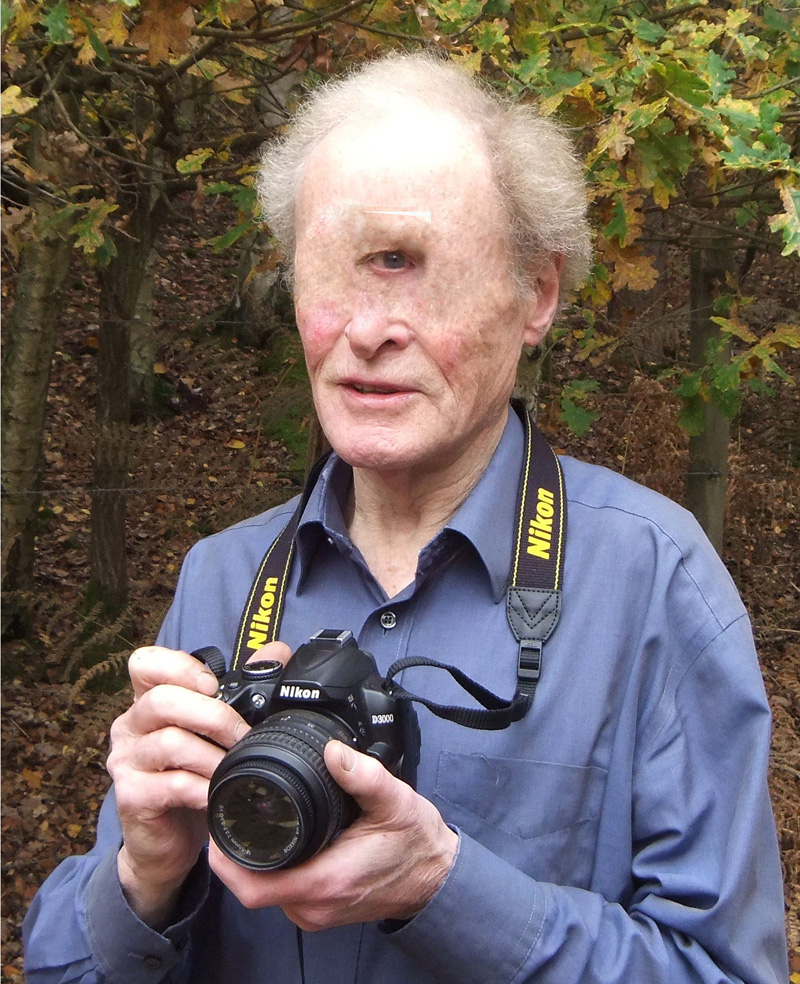
A Cyclopean individual – is this you?
An exposition of how to see cross-eye stereo-pair pictures
© Charles Warner 25 September 2016
"Relaxed-Eye" stereo-pairs, normal for members of the Stereoscopic Society, are easier to see than "Cross-Eye" stereo-pairs. The former have the Left Eye view on the left and the Right Eye view on the right; the latter have the Right-Eye view on the left. There are a few members who free view in the manner described here. People try about 3 times and give up; it takes about 9 tries. That means 2 minutes of effort consistently every day for 9 days - less onerous than music practice. There will not be any discomfort if the effort is judged correctly.
The Totally Brilliant Ydea (TOBY) is that free viewing will become fashionable, like the ‘Magic Eye’ stereograms of Tom Baccei (N. E. Thing Enterprises, 1994: Magic Eye, a new way of looking at the world, Michael Joseph, London). Under Arts and Media in Time magazine of 3 October 1994 appeared the article "Staring in Stereo" ... without glasses. Hundreds of thousands of readers enjoyed these relaxed-eye multiple stereo-pairs, generated by computer. This was just a game. It was not a new way of looking at the world, but free viewing of cross-eye stereos is. It should become a great and lasting asset, general enough to merit a special section in newspapers and magazines. Ambitious 20-year-olds, please take note.
Gentle reader, you will be doing something new, interesting and profitable by following the course.
Be prepared in life for great WOW moments. For the great British cyclist Mark Cavendish a first great WOW moment was escaping from the gentle hand of his father on learning finally to ride his bicycle at the age of 3. He conditioned a set of reflexes. Now I show you how to do this too, for pleasure and profit.
South Americans missed much gold in the sixteenth century as a result of failing to encounter a WOW moment by inventing the wheel. Instead they liked to cut steps all over the Andes, and they fell foul of the expert Spanish military adventurers under Francisco Pizarro in 1532-3. Go to Peru and improve on my stereo-pair of Machu Picchu taken from two extremities ~ 20 m apart - a "baseline" - at the top of Huayna Picchu. Don't fall; don't miss out.
Try to imagine Galileo looking through his telescope in ~ 1610. WOW. He took a lot of trouble. Stereos are no trouble.
So, gentle reader, please read on and enjoy many many wows.
We have two eyes, not just one like the Cyclops
of Greek mythology. Thus we have excellent depth perception in our everyday lives.
We would object strongly if asked to go about wearing a patch over one eye.
But when we go on holiday we come back with collections of single photographs.

A normal photograph is just one picture - a one-eyed view which does not show distances. You can as easily take two pictures, a left-eye picture and a right-eye picture. Lay this stereo-pair side by side, see the left-eye picture with the left eye and the right-eye picture with the right eye, and a usual binocular (two-eyed) impression is obtained in all its glory.
This book is to show how to see stereo-pairs. Anything essentially three-dimensional is best viewed in stereo. Examples are given here. They are easy to take; they provide a faithful record of three-dimensional details and cross-eye viewing is instantaneous. There are many potential applications in gardening and botany, among creatures, buildings, mountains and clouds, machines and molecules.
Most people are capable of seeing stereo-pair pictures without the aid of a stereoscope, a special device to view different pictures simultaneously. No special abilities are required. Stereo-pair pictures allow one the excitement of seeing the hitherto unseen: -
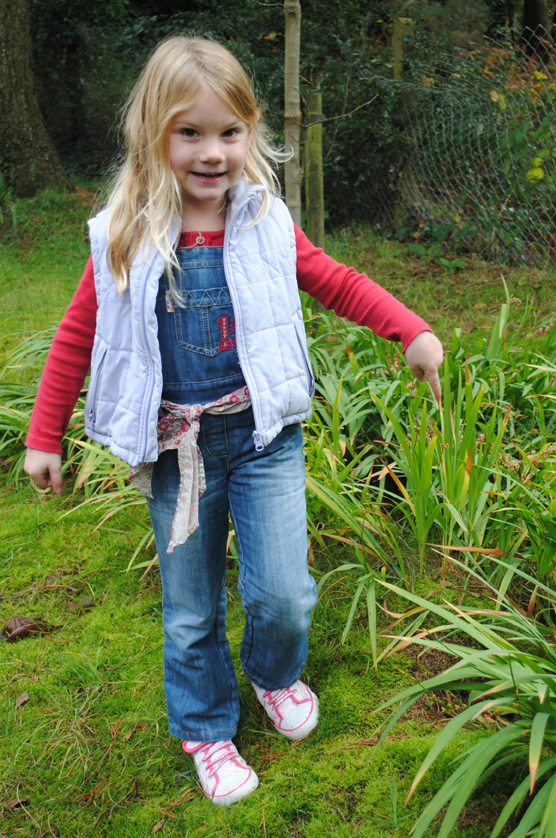
Newspapers and journals and bookshops should regularly show cross-eye stereo-pairs, and children should compare their favorite stereo cards. Here are great commercial opportunities.
Try this. Sit down with your newspaper. Have a waste basket two metres away. Read your newspaper from the middle outwards. As you finish each double page spread screw it up into a ball and throw it carefully at the waste basket. (How many times did you score a hit? If the answer is none I am sorry; this technique may not be for you.)
To hit the basket with the balls of newspaper you throw with the muscles of your arm. When you throw a glance at something you throw with the muscles of your eyes. To see 3D, stereo-pair, pictures, throw with the muscles of your eyes in a way slightly different from the usual.
It is very complicated just to throw an ordinary glance. Each of your two eyes has to be pointed at the object, and each eye has to be focused on the object. Four different functions are coordinated. We normally get so good at this kind of throwing that we can switch glances instantly, and follow moving objects. The brain co-ordinates the muscles and locks on with ease.

The complexity and the speed with which eyes and brain operate are remarkable (see the book Eye and Brain, The Psychology of Seeing, by R. L. Gregory, Oxford University Press, 1998). The brain makes use of previous experience in its operations, learns what to expect, and catches on.
Seeing a stereo-pair involves brain activity similar to that of ordinary vision, but the functions of pointing and focusing are concentrated on the each of the two members of the stereo-pair, one for each eye. The brain finds the appropriate muscular adjustments and locks on. This is well within the scope of normal seeing. Only in cases of amblyopia will there be difficulty. Acquisition of a new conditioned reflex, a mental accomplishment, is all that is necessary, like learning to ride a bicycle. Good muscular coordination is obviously helpful, and one would expect aviators, motorcyclists, dancers and ping-pong players to catch on faster than the rest of us.
[In the carefully prepared presentation of their first stereo camera,
Fujifilm wrote the following Caution: Using the FinePix
REAL 3D W1: -
2D display is recommended for young children (up to the age of about six) whose visual system is still
maturing and for individuals with notable differences in vision
between their two eyes,
who may find it difficult or impossible to observe the 3D effect.
Should you experience fatigue or discomfort while viewing 3D images, cease use immediately.
A ten-minute break is recommended about once every half hour. Switch to 2D immediately
if 3D images still appear double after you have adjusted parallax.
Individuals with a history of photosensitive epilepsy or heart disease or who are unwell
or suffering from fatigue, insomnia, or the effects of alcohol should refrain from viewing 3D images.
Viewing 3D images while in motion may cause fatigue or discomfort.]
With a relaxed-eye stereo-pair the left-eye picture is mounted on the left and the right-eye picture on the right, and the eyes look straight at the respective pictures.
Suppose that you are standing in the middle of a church, looking up from the floor at the structure of its spire. In the left-eye view the middle part, the highest, will be slightly left of centre; in the right-eye view it will be slightly right of centre. Laid side by side, the left- and right-eye views will be as shown below. Lower your head towards the middle of the diagram until it is close to your eyes. Relax all your eye muscles (breathe out). Allow your eyes to see three blurred squares. Forget the two outer ones on the edge of your field of view. Just look at the middle square. Now slowly move your head away to a comfortable distance. The middle square will come into focus. You will see up into the church spire, the inner circle far above, then the middle circle, with the outer frame quite close above your head. The flat screen yields a wonderful impression of depth.



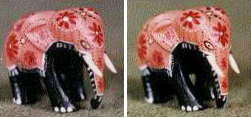

Relaxed-eye stereo-pairs are fairly common. They appear sometimes in the journals Nature and Science for illustrations of the structures of complicated chemicals. They are limited in that the size of each image can be no greater than the separation between a person’s eyes, about 65 mm.
Photographic prints are commonly 12 cm wide, and we want to see these as stereos.
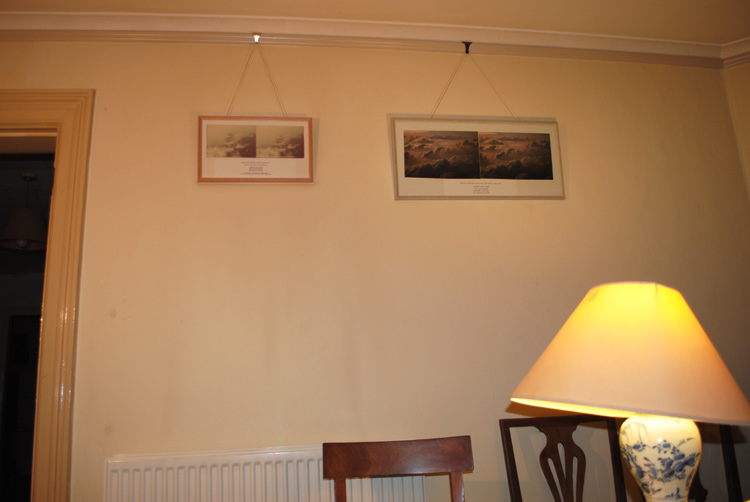
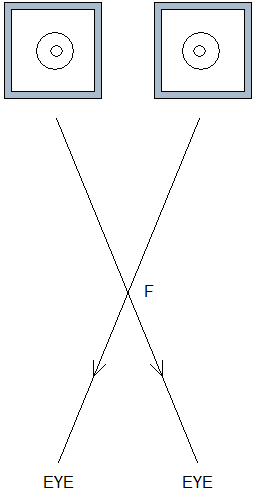
The view up into the church spire picture is now presented with the left-eye picture on the right. Underneath is shown the path of rays of light to each eye. Focusing is on the pictures, while rays cross at F, nearer to the eyes. Crank in the muscles which point the eyes as though squinting at something close up, but keep the focusing muscles more relaxed, as appropriate for normal comfortable focusing. Once you have learned the conditioned reflex, cross-eye viewing is like simply flicking a switch from normal to stereo settings. The brain locks on to the stereo.

Hold up your two thumbs in front of you side by side. Squint a little and make three thumbs.
Relax your focusing and see the middle thumb in focus. This is the same as seeing a stereo-pair.
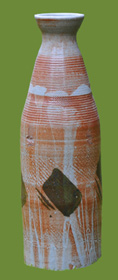
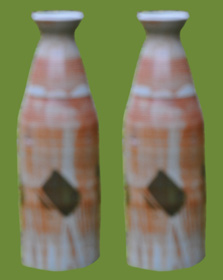
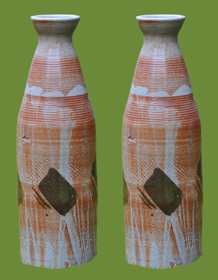
Cross-eye viewing imposes no special strain on your eyes. Close study, as for needlework or watch repair, requires both crossing your eyes and focusing them closely. Cross-eye viewing involves crossing your eyes as for close work, but focusing at the normal comfortable range. It is less strenuous. (If you do have any problem, just go to a dark place for a few minutes.)
While making the effort to see cross-eye, remember occasions when faced with a boring harangue by someone arguing a point of view. "Oh I give up" one thinks to oneself as one's eyes relax and glaze over: that feeling is much the same as that which occurs when looking cross-eye.
Returning to the shark and viewing him cross-eye, we find that the two escaping fish are closer, rather than further away from the observer.
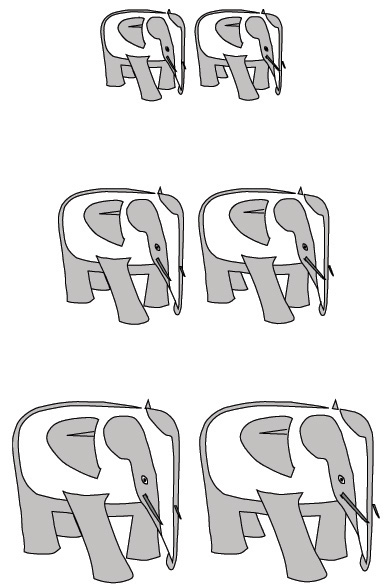
The following photographs illustrate some of the wonderful merits of stereo-pairs. Some of these are relatively easy to see in stereo, with one central group of objects. Post up a stereo-pair in a place where you will often see it. Try stereo viewing now and again for no more than a few seconds at a time. Expect success after about nine independent tries. Independent tries should be made on nine consecutive days. Each try should last from 2-3 minutes to no more than about 8 minutes, to avoid becoming tired or fed up. A stunning accomplishment is expected from a very small total investment. Just follow this plan (and no other).
A year has 12 months: the published version of this book is to end with a Stereo-Pair Calendar, probably helpful.
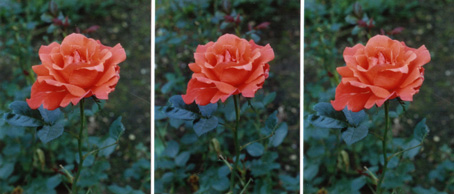
I have made small cards like this to facilitate learning to see stereos. They have to be small because relaxed-eye viewing demands a picture size no greater than eye separation, 65 mm.
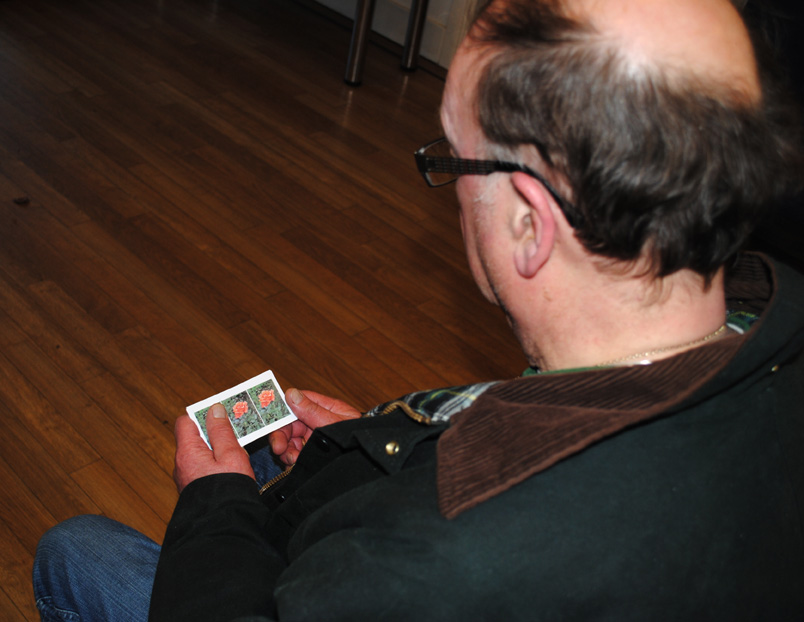
["But I don't want to see stereos," said Alice.
"Oh you can't help that," said the Cat; "we all see them here - relaxed-eye, cross-eye."
"Relaxed-eye sounds better to me ..," muttered Alice.
"It would if you're lazy," said the Cat.
"I'm not lazy! I don't want to get cross," argued Alice.
"You can't see relaxed-eye and cross-eye at the same time," said the Cat;
"you have to choose which way you want."
"But I don't want ..," said Alice.
"You have to want something," said the Cat.
"But why .."
"Just try crossing your eyes - I can," the Cat went on.
After some attempts Alice did acquire a cross-eye stereo.
"Actually I find that quite straightforward," she said.
"Just like everybody else," added the Cat. "Wonderland awaits."]
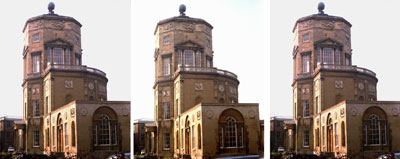

This figure illustrates a variety of objects fairly close together to provide nice contrasts, while there is no excessive variety of angles subtended at the eyes, so it is comfortable to switch attention from one little object to another. The angle subtended at the centre of interest by the two eyes should be roughly 8°. This is not critical. Closest discernible objects are at 10 cm; with eyes 65 mm apart the angle subtended is then 36°. At close range some effort is required to cross the eyes. I have a millimetre ruler marked in black on a white background. The greatest distance at which I can discern the millimetre divisions is about 3 metres; the corresponding angle is 0.02°. At far range details become indiscernible.The angle subtended must be between 36 and 0.02°. An angle subtended of 12˝° corresponds to a comfortable reading range of 30 cm. Angles subtended near 8 to 4° are satisfactory. (The corresponding distances are 46 and 93 cm.) It is best to have a neutral background, and no intrusions of extraneous objects into either left- or right-eye view.
It is good to rehearse left- and right-eye photographs before taking them. Both views should be aimed at the main object of interest in the middle of the field of view. If the aiming point is different in the two pictures, stereo will be lost at the edges. View-finding through the lens, with a Single Lens Reflex camera, is an advantage for objects close to the camera such as plants, so as to see exactly how they will fit into the field of view. However, slight inaccuracy does not matter.
The two views of a stereo-pair contain more information than just one; in effect they join forces. It does not matter if the exposure or the focus of one of the views differs slightly from that of the other. Different camera settings may be chosen for the two views. If one has a digital camera with a certain resolution, a stereo will be seen with a better resolution than this, because one is synthesizing two overlapping images. The final stereo has greater resolution than each individual picture. Good results come easily with stereo-pair photography.
I used to have a stereo attachment to fit over the front of my camera and divide the field of view into two halves, corresponding to two eyes 70 mm apart.
I used my Fujifilm 3D W1 stereo camera, with two lenses 77 mm apart, bought in March 2010, to record Work Party
activity on Elstead Common by the Ramblers (2 Aug 11):
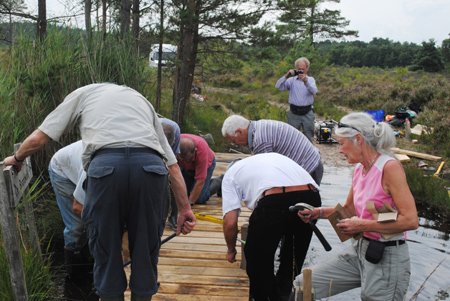

The Fujifilm 3DW3 camera, successor to the W1, has a movie capability and a lens separation of 75 mm. An ordinary digital Single Lens Reflex camera allows choice of baseline to suit the subject.
On 23 Aug 11 I was glad to have the 3DW1 for the turbulent waters of the river Aare near Meiringen in Switzerland (just downstream of the Aareschlucht; thanks to Atsumu Ohmura for photographing me.):

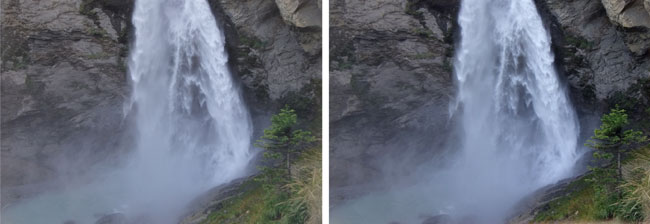
This waterfall is an ideal subject for a stereo camera, although here the Aareschlucht was too far away to see details of the spray. Note the tree on its rocky ledge at bottom right.
A marvel of modern engineering, the 3DW1 is useful chiefly for an introduction to stereo, in my experience. Introduced in late 2010, the 3DW3 has improved screen resolution, lenses separated by 75 mm, and is intended for High-Definition home movies. A special camera generally is not necessary; just take two pictures as usual, from places slightly separated.
The Fujifilm 3DW3 would be ideal for police work, where a standard baseline (the 75 mm built in to the camera) would be desirable. Car accidents could be recorded with acceptable precision without the need for elaborate survey work with tape measures. Just a few fiducial measurements would be necessary; there would be little need for long queues of frustrated drivers.
Crime scenes could similarly be recorded by forensic stereo-photographers.
As presented on my webpage www.cloudstereo.org.uk, botanical stereo-pair photography would seem to cry out for development. Single photographs of individuals and groups of plants are often very confusing. There should exist a number of specialist stereo-photography botanical books, for instance on tree bark.
I have photographed elephants with EXPLORE in Kruger National Park, at long range with my Nikon, and lions with my stereo camera at ranges of a few metres. Many more close-range wildlife stereo photographs could be taken. This is a strength of the Stereoscopic Society.
Geology is another promising subject area. I photographed caves in an outlying peak of Tien Bao Shan, a limestone mountain in Yunnan, on a long baseline. Only after the event did I realize that I had a stereo-pair. The 40 m baseline - very long - produced an exaggeration in depth such as to suggest that the structures were much deeper than the reality. If repeated structures like a row of posts is photographed, other illusions can occur.
Short of time, how should archaeologists record exposed finds after a dig?
Clouds are best photographed by flying within them. Stereos taken from Concorde - well above the clouds - were disappointing. Absence of particles in the stratosphere made the sky dark. Cloud stereos may also be photographed from the ground as they pass by. One waits while the direction of the object of greatest interest changes by about 5°. Wait too long, and the cloud develops if it's a cumulus. With different speeds at different heights, ground-based stereos from a fixed position can yield distortions of perception. A fractional distortion of range (δr/r) corresponds with a fractional distortion of speed (δs/s). If the cloud is further away than you think it is, it is moving faster than you think it is. I have only a few cloud stereo-pairs interesting for such reasons.
The only aspect of stereo-pair photography which calls for special care is the mounting of the two views side by side, as shown in the diagram below:
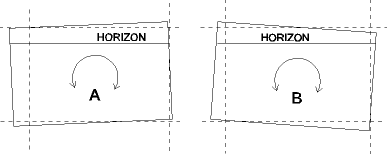
After placing the two views side by side, they can be moved up and down relative to one another, and also rotated as shown by the arrows A and B. The horizon should be aligned across the two views. Adjustments should be made until the result feels optimal when viewed in stereo. Precision is not vitally important. Having settled the relative placement of the two views, trimming top and bottom should be parallel to the horizon. Trimming at the sides should be such as to exclude material not present in both views, to make the views as small in width as possible, concentrating on the object of interest. (Significant improvement can come from changing slightly the magnification of one of the pictures if the object of interest is at different ranges in the two views.)
Cross-eye stereo-pair viewing is within reach of most ordinary people. Acquisition of the conditioned reflex may at first be difficult, and may require as many as nine independent tries - tries separated by time when the subject is forgotten. When the facility is acquired, wonderful results are obtained, and satisfaction is profound.
One looks for stereo viewing to become part of ordinary education, with the media customarily presenting stereo-pairs to readers and viewers. "Magic-Eye" stereos caught on for a time during the 1990's, but went out of fashion. The great advantages of cross-eye viewing should have a wide and lasting general appeal.
Google Earth presents many views distinguished by the quality of photography. I look forward to the time when cross-eye stereo-pairs are regarded as commonplace and are accepted there for presentation.
An excellent program called StereoPhoto Maker is now available: http://stereo.jpn.org/eng/stphmkr. I thank Tony Bignell for introducing me to this.(back)
Gale Rhodes gives an eloquent introduction to stereo viewing - essential for structural chemists - at spdbv.vital-it.ch/TheMolecularLevel/0Help/StereoView.html
I thank Alexander Klein, Treasurer of the International Stereoscopic Union, for pointing to an elegant stereo of an interesting chemical.
Boris Starosta presents superb cross-eye art work at www.starosta.com/stereo.html
Images of Mars may be found at www.stereoscopy.com/mars/
1:30 rule. For ease of viewing, Eye separation should be 1/30 of the range to the object of interest. The angle subtended at the object of interest by the baseline is then 1.9°. I recommend greater angles. See the article by Ron Bevan, "Aerial Stereophotography with the Royal Air Force", Journal of 3D Imaging, Number 171, Winter 2005/6, The Stereoscopic Society, 16-21.
Amblyopia. The medical term used when the vision in one of the eyes is reduced because the eye and the brain are not working together properly. Affecting up to 5% of children, this disorder may persist into adulthood. See under the U.S. National Eye Institute Amblyopia.
Autostereogram. A single image stereogram designed to create the visual illusion of a three-dimensional scene. See Autostereogram.
.Baseline. The separation between the Left- and Right-Eye positions.
Cross-Eye. Right-Eye images are placed at left, and vice versa.
Hyperstereo. A stereo-pair taken with Eye separation greater than the 65 mm separation between human eyes. Most of my stereo-pairs are hyperstereos.
Hypostereo. A stereo-pair taken with Eye separation less than the 65 mm separation between human eyes. See the cover images of small creatures by Bob Pryce in the Journal of 3D Imaging, Number 204, Winter 2016, The Stereoscopic Society.
Lazy eye. A name for Amblyopia.
Magic Eye. The name for autostereogram multiple Relaxed-Eye stereos generated by computer after the manner of Tom Baccei. These make appear the outline of an object within an abstract background.
Orthostereo. A stereo-pair taken with Eye separation equal to the 65 mm separation between human eyes. See the article by Soham Mandal, "My Stereoscopic 3D Project", Journal of 3D Imaging, Number 204, Winter 2016, The Stereoscopic Society, 31-3.
Relaxed-Eye. Left-Eye images are placed at left and Right-Eye images at right. Relaxed eyes are aimed at infinity.
Stereoscope. A device into which Left- and Right-Eye views may be placed to make possible viewing.
Wall-eye. Another expression for Relaxed-eye, used by Wikipedia.
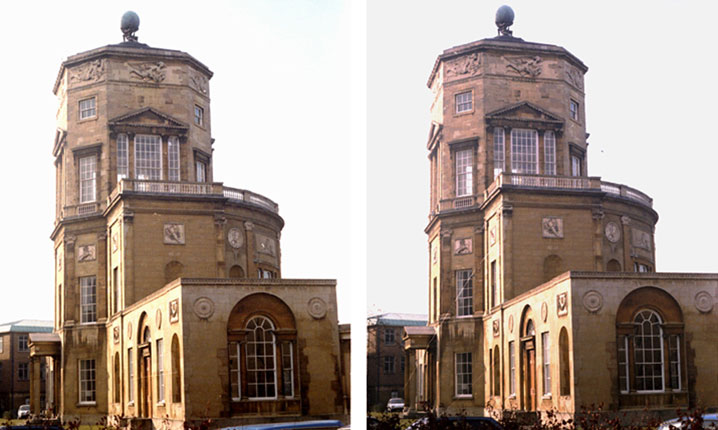
In the published version the Calendar follows, with further stereos taken from the bulk of this page.
This thorough exposition of stereo photography compels the reader to make the many efforts necessary to see cross-eye stereo-pair pictures. A craze for looking at them is anticipated, comparable with that for Tom Baccei's Magic Eye stereograms in the early 1990s. The fashion will settle down to a steady activity of lasting value for all forms of three-dimensional studies and enjoyment. New activities will begin. Sport will be recorded in stereo. Police work will be improved and eased, and money saved. Sciences will benefit. Benefits beyond imagination will be discovered.
Born in 1938 in prosperous southern England, Charles Warner (HNC, MA, Ph.D) was educated at Radley College in Oxfordshire. He learned stereo photogrammetry with the Stormy Weather Group at McGill) University, Montreal, with a doctoral thesis (1971) on visual and radar aspects of large convective storms. Sometimes under the pseudonym Jetsamoocow, Charles has been taking stereo-pair photographs since 1968. Since then he has been persuading others to share the pleasure and profit, and only recently realized the best approaches to this end. Unmarried, Charles has learned much from membership of the Royal Ocean Racing Club, hiking with the McGill Outdoors Club (MOC), running with the Charlottesville Track Club, the adventure tour company EXPLORE, and with the cultivated connoisseurs of Naturetrek. He has crossed the Atlantic Ocean both very slowly under sail, and very fast aboard Concorde. His website cloudstereo.org.uk gives details of his many and varied interests. He lives in Hindhead.